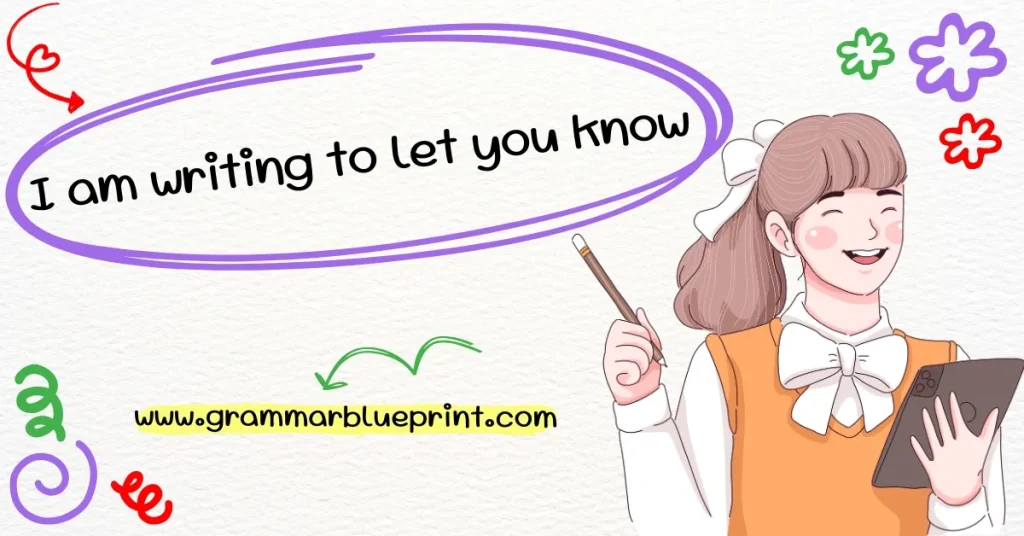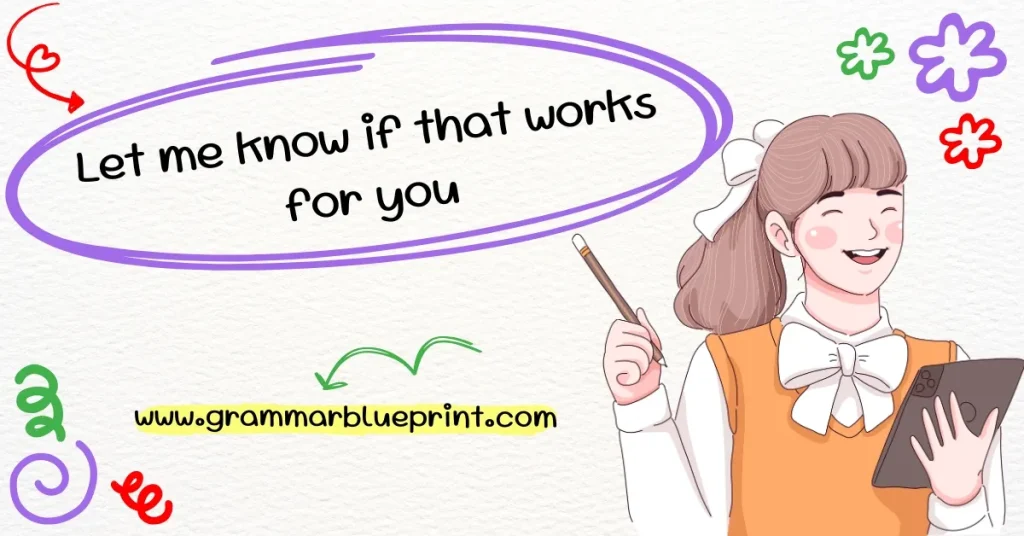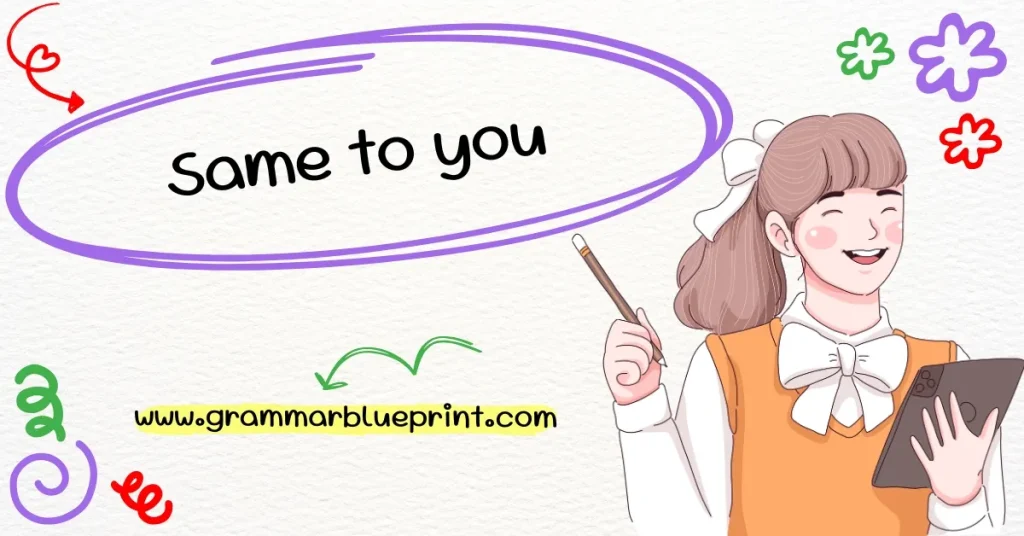Have you ever found yourself starting an email with, “I am writing to let you know”? It’s a formal phrase that can sound a bit stiff, but it’s essential in business, academic, and professional communication. In this article, we’ll explore how to use it effectively, along with some of its popular alternatives.
What is “I Am Writing to Let You Know”?
When we say “I am writing to let you know,” we’re typically starting an email or letter with a purpose: to deliver information. The phrase itself is a polite, formal way of introducing the main point of your message. It signals to the reader that the purpose of the communication is to inform or update them.
Meaning and Definition
The phrase simply means that you are writing to provide someone with specific information. It’s often used when delivering updates, notifying someone of something, or sharing important details.
Why It’s Important
The phrase is a staple in formal business writing because it sets the tone right away. It shows professionalism and is direct in its purpose. You’re not just sharing an update; you’re making sure the recipient understands your intention to inform them.
Why Use “I Am Writing to Let You Know”?
Importance in Formal Emails and Letters
The key benefit of using this phrase is that it’s direct, polite, and formal, making it ideal for professional settings. Whether you’re sending an email to a colleague, a client, or a boss, this phrase helps establish clarity from the get-go.
In the workplace, clear communication is paramount. Starting your email with this phrase sets the tone and immediately lets the reader know that you have important information to share.
Professional and Polite Tone
“I am writing to let you know” isn’t just about the words—it’s about the tone. In professional writing, a polite, neutral tone is necessary to maintain respect. This phrase does exactly that. It’s not too formal or overly casual, striking the perfect balance.
How to Use “I Am Writing to Let You Know” in Sentences
When it comes to using this phrase, structure is key. Below, I’ll show you step-by-step how to incorporate it into your emails. You’ll also see examples of how to tailor this phrase to different contexts.
Step-by-Step Guide to Constructing Sentences
- Start with the Subject: Always ensure your subject line provides context, like “Update on Project Status” or “Notification Regarding Office Changes.”
- Use the Phrase: The phrase usually starts the sentence. For example, “I am writing to let you know that…” or “I am writing to inform you that…”
- Provide the Information: After the phrase, add your main point. Be concise and clear with the details.
Examples in Different Contexts
- Business: “I am writing to let you know that the deadline for the project has been extended until Friday.”
- Academic: “I am writing to let you know that I have submitted my assignment on time.”
- Personal: “I am writing to let you know that I’ve arrived safely at my destination.”
Common Alternatives to “I Am Writing to Let You Know”
While “I am writing to let you know” is a solid choice, it’s always good to have alternatives in your vocabulary to sound more natural or tailored to different contexts.
1. I Would Like to Inform You
Meaning: A polite way to give information.
Best Use: Perfect for formal communication in business or academic settings.
Tone: Neutral but formal.
2. I Am Writing to Inform You
Meaning: A formal way of stating that you’re sharing important information.
Best Use: Professional emails or letters.
Tone: Formal and to the point.
3. I Wanted to Let You Know
Meaning: Slightly informal but still polite.
Best Use: Personal emails or when writing to someone you have a comfortable relationship with.
Tone: Casual, yet polite.
4. I Am Reaching Out to Let You Know
Meaning: This alternative is great for more conversational business contexts.
Best Use: When you’re contacting someone for the first time or with a softer tone.
Tone: Casual, friendly.
5. I Would Like to Notify You
Meaning: A more direct way to provide a notification.
Best Use: When you need to communicate something urgent or official.
Tone: Formal, direct.
6. I Am Writing to Notify You
Meaning: Indicates that the purpose of the communication is to make the recipient aware of something.
Best Use: Legal or official business communication.
Tone: Formal.
7. I Just Wanted to Tell You
Meaning: Slightly informal and conversational.
Best Use: Personal messages or when communicating with close colleagues or friends.
Tone: Friendly, informal.
8. I Am Writing to Update You
Meaning: Used when you’re providing an update on a situation.
Best Use: Perfect for status updates, reports, or project follow-ups.
Tone: Professional but approachable.
9. I Would Like to Update You
Meaning: Less formal than “I am writing to update you” but still suitable for business emails.
Best Use: Use in situations where you want to give the recipient an update.
Tone: Casual to semi-formal.
10. Please Be Informed
Meaning: Direct and formal.
Best Use: Good for important announcements or when you need to convey urgency.
Tone: Very formal.
11. I Am Writing to Bring to Your Attention
Meaning: Used to highlight something important that the recipient should be aware of.
Best Use: Suitable for legal notices, policy updates, or matters requiring attention.
Tone: Formal and authoritative.
12. I Am Reaching Out to Inform You
Meaning: A gentle way of offering information, often used in business or informal professional contexts.
Best Use: When you’re making initial contact or discussing something not urgent.
Tone: Semi-formal, approachable.
13. I Wish to Inform You
Meaning: A polite and formal way to offer information.
Best Use: Used in official or legal contexts, or when trying to maintain a formal tone.
Tone: Very formal.
14. I Would Like to Make You Aware
Meaning: Gently introducing important information to ensure the recipient understands the matter.
Best Use: Informing someone of a development or situation that needs attention.
Tone: Semi-formal, polite.
15. I Am Writing to Make You Aware
Meaning: Very similar to “I would like to make you aware,” this phrase directly points out the purpose of the message.
Best Use: Appropriate for emails related to corporate matters, scheduling, or task updates.
Tone: Formal and neutral.
16. I Would Like to Bring to Your Attention
Meaning: A formal way of directing someone’s focus to something important.
Best Use: When providing updates or requesting the recipient’s attention to a particular issue.
Tone: Formal and direct.
17. I Am Writing to Let You Be Aware
Meaning: Another formal phrase that implies the need to inform the recipient.
Best Use: Situations where you need to make the recipient aware of something important, such as deadlines or changes.
Tone: Formal.
18. Just a Quick Note to Inform You
Meaning: A friendly, lighthearted way to share information.
Best Use: Suitable for informal or internal emails when delivering non-urgent updates.
Tone: Informal, yet professional.
19. I Am Writing to Share with You
Meaning: Focuses on providing information to the recipient in a friendly and non-urgent tone.
Best Use: Good for emails in which you’re sharing ideas, files, or casual updates.
Tone: Casual but polite.
20. I Wanted to Update You
Meaning: A slightly informal phrase used for delivering an update or new information.
Best Use: Personal emails or professional messages with colleagues you have a comfortable rapport with.
Tone: Casual, friendly.
21. I Would Like to Share with You
Meaning: A soft and polite way of offering information or updates.
Best Use: For delivering new information or discussing updates with coworkers or clients.
Tone: Semi-formal, polite.
22. Please Be Advised
Meaning: A formal notification used to convey important details that require attention.
Best Use: Ideal for business emails, legal matters, or when an official tone is needed.
Tone: Very formal.
23. I Am Writing to Notify You Of
Meaning: Used to inform someone of something important that they need to know.
Best Use: Professional emails, particularly when notifying about changes or updates.
Tone: Formal and direct.
24. I Am Sending This to Let You Know
Meaning: Casual and informal, this phrase is typically used when sending an update or information.
Best Use: Internal emails or emails to people you have a friendly relationship with.
Tone: Informal and conversational.
25. I Wanted to Let You Be Aware
Meaning: A conversational way to inform someone of something they should know.
Best Use: Casual communication or when you’re passing on information of interest.
Tone: Informal but polite.
26. I Thought I Should Inform You
Meaning: A phrase used when you feel it’s necessary to provide someone with certain information.
Best Use: When the information isn’t urgent, but still important enough to share.
Tone: Semi-formal, considerate.
27. I Am Writing to Notify You About
Meaning: A formal approach to conveying information, usually used when notifying about a specific subject.
Best Use: Suitable for legal, policy, or corporate communication.
Tone: Formal and factual.
28. Allow Me to Inform You
Meaning: A formal, respectful way to introduce important information.
Best Use: Official communications or when providing important updates or decisions.
Tone: Very formal, respectful.
29. I Am Writing to Give You an Update
Meaning: Used when the main purpose of the email is to provide someone with an update.
Best Use: When you’re sharing progress or developments, such as project statuses or task updates.
Tone: Formal, but approachable.
30. I Wanted to Bring to Your Attention
Meaning: A polite and somewhat formal way to direct someone’s focus to something important.
Best Use: When there’s a need to highlight something important for the recipient’s awareness.
Tone: Formal, professional.
When to Use “I Am Writing to Let You Know”
Knowing when to use the phrase “I am writing to let you know” is just as important as knowing how to use it. It’s not a phrase you want to overuse, but when used in the right situations, it can add clarity and professionalism to your communication. Let’s dive into the scenarios where this phrase is most fitting.
Situations and Contexts Where This Phrase is Most Appropriate
- Formal Business Communication:
In a business context, you want to maintain professionalism, and “I am writing to let you know” works perfectly for informing someone about important developments, decisions, or changes. Whether you’re updating a colleague about a meeting change or letting a client know about a delay, this phrase ensures your message is conveyed in a clear and polite way. - Official Notifications:
If you’re communicating official notifications, whether it’s a change in company policy, an update about a product, or something that requires attention, this phrase does wonders. It instantly establishes the tone and purpose of the email. - Sharing Updates:
When you have to give an update on something that someone is waiting for—whether it’s a project’s status or an event’s schedule—this phrase is ideal. It lets the recipient know you’re actively keeping them in the loop. - Inviting Attention to Important Matters:
Sometimes you need to bring something to someone’s attention, but it’s not urgent. The phrase signals importance without sounding too urgent, which is crucial for professional communication.
How It Differs from More Casual Expressions
While “I am writing to let you know” is formal and business-like, it’s also less stiff than some other formal phrases. That said, it does differ from more casual alternatives like “Just letting you know” or “FYI” (for your information). These more relaxed alternatives are better suited for informal communication between friends or close colleagues.
- Casual Phrases:
- “Just wanted to let you know…”
- “FYI…”
- “I thought I’d tell you…”
- “I’m just dropping a quick note…”
These are great for casual emails or messages, but when it comes to maintaining a professional tone, it’s best to opt for “I am writing to let you know” or one of its formal alternatives.
Benefits of Using “I Am Writing to Let You Know” in Emails
Professional Tone and Clarity
One of the biggest benefits of using “I am writing to let you know” is that it sets the tone immediately. It signals that you’re conveying important information in a professional manner, ensuring that the reader knows what to expect from your email. The clarity this phrase provides is invaluable—no one will wonder why you’re reaching out.
Establishes the Purpose of the Communication Immediately
The moment someone reads “I am writing to let you know,” they know exactly what the email is about. This eliminates any ambiguity. It’s direct but not blunt. You’re immediately giving the recipient the information they need to pay attention to, whether it’s a change in plans, an update on a project, or something else that requires their focus.
Tips for Writing Polite and Clear Emails
Use of Proper Tone and Structure
When you’re using formal expressions like “I am writing to let you know,” it’s important to follow up with appropriate tone and structure in your entire email. Here are some quick tips:
- Be concise: Don’t use too many words to convey your message. Once you’ve used “I am writing to let you know,” get to the point and provide the necessary details.
- Stay polite: Always use polite language in follow-up sentences. Simple words like “please,” “thank you,” and “kind regards” show respect.
- Use paragraphs: Break your email into short, digestible paragraphs. This keeps the message easy to read and ensures that important information doesn’t get lost in a sea of text.
Common Mistakes to Avoid When Using Formal Expressions
- Overusing formal expressions: Using “I am writing to let you know” in every email can make your writing sound robotic or overly repetitive. Vary your phrases and switch to more casual alternatives when appropriate.
- Being too blunt: Although this phrase is formal, it’s still important to soften your tone when delivering bad news. Phrases like “I regret to inform you” or “Unfortunately, I must notify you” can be helpful when delivering negative information.
- Long-winded emails: Avoid rambling! Once you’ve introduced the purpose of the email, keep your explanation brief and to the point. Long emails can lose the recipient’s attention and make the content harder to digest.
Grammar and Vocabulary Insights
Correct Grammar Structures with Examples
When using “I am writing to let you know,” it’s important to follow correct grammar rules. Here are a few tips:
- Subject-Verb Agreement: Always ensure that your subject and verb agree. For instance:
Correct: “I am writing to let you know that the meeting is rescheduled.”
Incorrect: “I am writing to let you know that the meeting are rescheduled.” - Tense Consistency: Keep the tense consistent. If you’re giving an update, make sure the tense matches the time frame.
Correct: “I am writing to let you know that the event has been moved.”
Incorrect: “I am writing to let you know that the event had been moved.”
Expanding Vocabulary for Professional Communication
When crafting emails for professional communication, it’s useful to expand your vocabulary. Some variations of “I am writing to let you know” include:
- “I would like to inform you”
- “I am reaching out to notify you”
- “I wanted to update you”
These subtle changes can help keep your emails fresh and interesting while still maintaining professionalism.
Practice Exercises
Want to master this phrase and all its alternatives? Here are a few exercises to help you practice:
- Fill in the Blanks:
Write a formal email to a colleague about a project update using “I am writing to let you know” or one of its alternatives. - Sentence Building:
Practice using “I am writing to let you know” in different contexts (business, academic, personal). Try to make your sentences sound natural and clear. - Rewriting Emails:
Take an email you’ve written and rewrite it using one of the alternatives. How does it change the tone? How do you feel about the impact?
Conclusion
Now that we’ve explored the ins and outs of “I am writing to let you know,” you should have a solid understanding of how to incorporate this phrase into your formal communication. Here’s a quick recap of the key takeaways:
Why It Matters
Using phrases like “I am writing to let you know” is an essential skill for maintaining clarity and professionalism in your emails. It’s polite, direct, and respectful, setting the stage for clear communication right from the start. In business, academic, and personal settings, this kind of clarity is crucial to ensuring that the recipient understands your message.
Keep It Polite, Clear, and Appropriate
Remember, while this phrase is excellent for formal communication, the key is to use it in the right context. It’s most effective in professional emails, legal notices, or official updates. When you need to convey information with authority but still remain polite, this phrase does wonders.
Practice Makes Perfect
Like with any aspect of writing, the more you practice, the more natural this formal writing style will become. Use the exercises from earlier to help sharpen your skills. Soon, you’ll find that your emails are more effective, clearer, and polished.
And lastly, don’t hesitate to explore alternative phrases when the situation calls for it. Expanding your writing toolkit will ensure you can always adapt your communication style to suit different contexts and tones.
Final Thoughts
Mastering formal email writing takes time and practice, but the rewards are immense. Whether you’re updating a colleague on a project, notifying a client about a change, or simply keeping someone informed, knowing how to craft clear, professional messages is an indispensable skill.
By integrating phrases like “I am writing to let you know” and its alternatives, you’re well on your way to improving your communication in English. So, what are you waiting for? Go ahead and put your newfound knowledge to the test!



